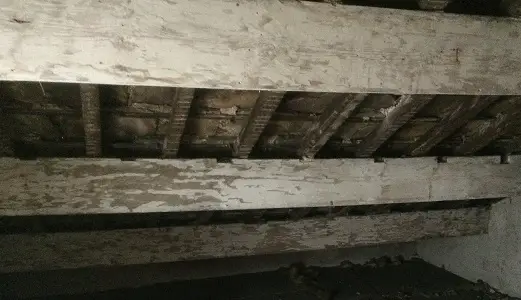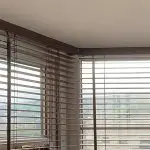The DIY Fix is reader supported. When you buy after clicking a link on our site, we may earn an affiliate commission.
Condensation is the most common form of damp found in the home. It tends to be more of a problem in rooms that are humid and moist, such as kitchens and bathrooms. Yet, condensation can occur in any room in the home – including the attic.
So, how do you stop condensation in your attic? Generally, condensation in an attic will be a result of poor ventilation. Moisture in an attic could also be caused by penetrating damp or a leaky roof. So, establishing any building defects is also very important. Defects causing damp in the attic should be identified and addressed first.
The most obvious ways to deal with condensation in your attic are:
- Fixing poor ventilation
- Installing extraction
- Using a dehumidifier
- Insulation
- Stopping moisture from other areas of the house reaching the attic
- Fixing any defects that could be letting moisture in

Establishing whether you have a roof leak
First, it makes sense to check if other types of damp could be causing moisture in the attic. This will make it clear whether the problem is down to condensation or not.
Often homeowners notice moisture in the attic and immediately fear the worst. They think it’s a sign that they have a more serious problem, such as a roof leak.
The good news is this is not usually the case.
Of course, roof leaks do sometimes occur. If you have a problem with the roof such as damaged or slipped tiles, water will penetrate from outside. If it goes unnoticed for too long, it could lead to further problems. Defects in a roof covering are usually noticeable quite quickly. The volume of water that penetrates gives rise to damp stains on the ceiling. This makes it easier to spot.
Identify and treat any building defects first. Then you can move on to addressing the issue of condensation. Let’s look at the reasons why attics are so susceptible to condensation.
Why does my attic have condensation?
Attic condensation most commonly occurs when warm, moist air from other areas in the home rises into the attic space. As warm and moist air comes into contact with the cool underside of the roof – condensation occurs.
During the winter, attic condensation can turn into frost. This isn’t usually a problem. But, when the frost melts, it turns back into water. This makes everything it comes into contact with wet. This can make rafters, frames, and other materials vulnerable to rot and mould. Which can lead to much bigger problems in the long term.
Poor insulation and ventilation in the attic are by far the most common causes of attic condensation. Some common signs of attic condensation include:
- Damp or wet wood and insulation
- Dark stains
- Water marks in the floor
- Evidence of rust.
You should also look out for signs of rot and mould. Also look for any signs that water has trickled down the walls. There might also be a musky, damp smell.
How do I stop condensation in my attic?
Improving attic insulation and attic ventilation are crucial to stop attic condensation. Both are quite straightforward and can be done DIY. Let’s have a look at the basics of both.
You should have a decent layer of insulation. This layer should be placed between the ceiling joists. The goal here is to insulate and stop heat moving up into the roof. Don’t forget to insulate the loft hatch as well.
Poor ventilation in the attic can be a real problem. Condensation will naturally occur as warm, moist air rises up. This is why insulation is so important. But the problems are exacerbated if the attic has poor ventilation too.
Conversely, the better the insulation is at ceiling level, the colder the attic will be. This actually makes the risk of condensation greater.
So the risk needs to be minimised and controlled. You should try to reduce the amount of moisture rising up into the attic in the first place. Everyday activities, such as cooking, drying clothes and showering will create moist air. This will dissipate naturally around the house and up through the ceilings. You need to check for any gaps that could be enabling moist air to rise into the attic. It’s also important to check that extractor fans in the kitchen and bathroom are working. It’s also important that fans are ducted out through the roof.
Of course, the attic itself needs to be ventilated too. This reduces the likelihood of condensation occurring. There should be a strong air flow. Ideally, above the insulation, the attic should feel cool and breezy. Check that any existing vents are clear and unblocked. It might be necessary to add more vents to increase the levels of ventilation.
Ensure the sources of moisture rising into the attic are reduced. The attic, when properly ventilated, should see condensation soon disappear. Deal with it promptly and there will not be any lasting damage – other than discolouration to the timbers. But, if condensation is left untreated, timber treatment work becomes necessary.
Noticing the warning signs
Condensation is usually first noticed on windows throughout your home. This is the result of excess humidity in the property. It can also be a warning sign. This could mean humidity is causing problems in places you cannot see, such as the attic roof.
Conclusion: control indoor humidity
If you want to stop condensation in your attic, you need to control the humidity in your home. Bathroom and kitchen fans should always be discharged outside. They should never be routed into the attic space. If you haven’t got fans in the kitchen, bathroom or laundry room, you should invest in them. Dehumidifiers are another inexpensive way to reduce moisture in the home. It might also be the case that extra roof vents would be a real benefit. These would give the warm air in the attic space to escape.




